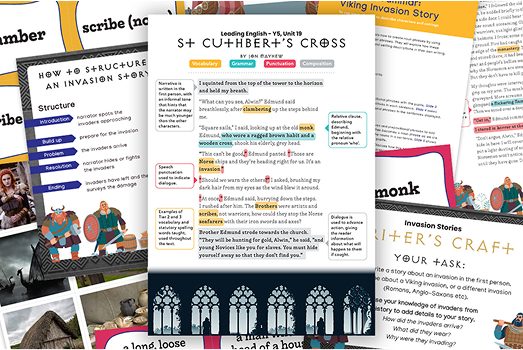When cohesion in writing is left to chance, even the best ideas unravel by paragraph two. Leaders who don’t tackle it risk weaker outcomes, more workload and frustrated pupils.
The opening paragraph might be confident – a purposeful sentence, strong vocabulary, a clear idea. But by the second paragraph, the thread begins to fray. Ideas drift. By the end, momentum is lost.
By contrast, where cohesion is mapped, modelled and revisited, pupils write with clarity and control.
This is leadership work. It’s not a sign of a lack of pupil effort. The Writing Framework (July 2025) makes it clear: “Creating coherent texts relies on pupils’ firm understanding of both sentence structure and paragraph organisation” and “Pupils should learn to write with clarity, awareness of audience and purpose, and an increasingly wide knowledge of vocabulary and grammar.”
Cohesion isn’t just flow. It’s what makes writing purposeful. Without it, ideas collapse into fragments. With it, pupils learn to shape writing for a reader and sustain meaning across a text.
The gap leaders cannot ignore
Across schools, three issues hold writing back:
- Teaching stops at the sentence: Pupils learn grammar and vocabulary, but can’t sustain ideas across paragraphs.
- Cohesion is reduced to connectives: Staff encourage “Firstly” or “In conclusion” without teaching structure or logic.
- Feedback misses purpose: Pupils are told their work is “correct,” but not whether it convinces, informs or guides a reader.
Leaders who ignore these gaps face a bigger problem: writing that looks busy but achieves little. Outcomes flatten. Teachers get frustrated. Pupils stop seeing themselves as writers.
Five transformational shifts
Here’s how to move cohesion from assumption to entitlement in your school...
1. Treat cohesion as curriculum knowledge
If cohesion isn’t in the progression model, it won’t be taught consistently. Leaders need to ensure paragraph structure is planned across years, so pupils can adapt their writing to different audiences and purposes. Without this, staff default to “ticking off genres,” and pupils never build the deeper skills they need.
2. Move from connectives to coherence devices
Medium-term plans that list “connectives” are a red flag. Cohesion is about coherence: argument, contrast, consequence, elaboration. If leaders don’t demand this shift, teachers keep recycling linking words, and pupils leave school without knowing how to structure an argument or sustain a narrative.
3. Elevate modelling to reveal writers’ decisions
Shared writing often shows the product, not the process. But audience and purpose depend on decisions. Teachers should narrate: “Because this is for a formal audience, I’ll guide the reader carefully. Here I’ll add a counterpoint to strengthen my case.”
When leaders don’t build this into CPD, teachers fall back on modelling outcomes, and pupils never see the thinking that makes writing work.
4. Align feedback with structural expectations
Feedback must ask: Does this writing achieve its purpose for the reader? If not, it’s just a correction. Leaders who fail to embed structural feedback create a cycle of cosmetic improvement – writing that looks correct but lacks clarity and meaning.
5. Embed cohesion in progression and CPD cycles
The Writing Framework says cohesion must be mapped, modelled and revisited. But unless leaders make it part of training, moderation and monitoring, it will remain inconsistent.
Without embedding cohesion into CPD, Year 6 pupils may still produce disjointed texts despite years of effort.
Why this matters for leadership
The Writing Framework is clear: “Teaching pupils how to construct sentences and paragraphs is key to their ability to create coherent and purposeful texts.”
Again, this is leadership work. Cohesion doesn’t improve because a few clever lessons happen. It improves when leaders make it:
- mapped into progression
- modelled in teaching
- rehearsed in drafting
- reinforced in assessment
Without this, schools spend hours on CPD and planning but see little improvement. With it, pupils learn to write with clarity, purpose and confidence.
How we can help
At Leading English, we partner with leaders to:
- embed cohesion as planned curriculum knowledge
- strengthen modelling so staff show decisions, not just outcomes
- align feedback with audience and purpose
- build consistency across classrooms and schools





